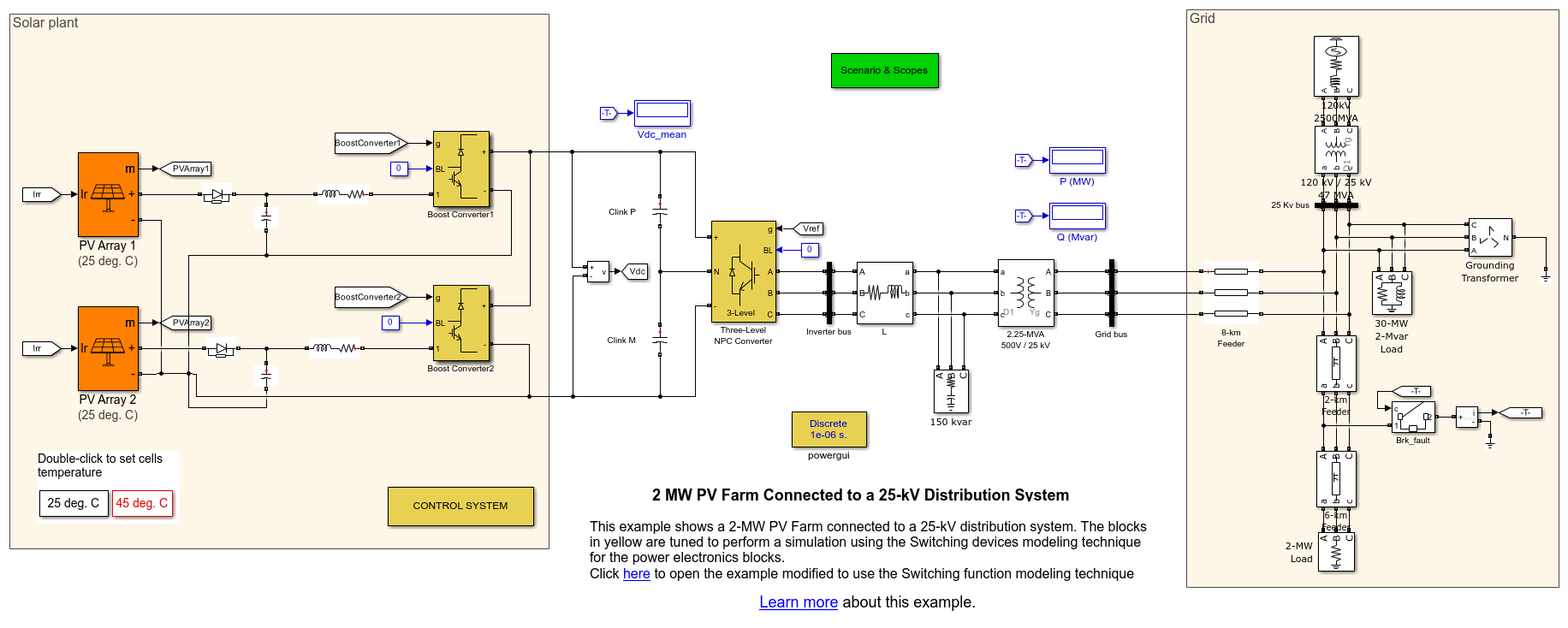2-MW PV Farm Connected to a 25-kV Distribution System
This example shows a model of a 2-MW PV farm connected to a 25-kV distribution system.

Description
The PV farm consists of two PV arrays: PV Array 1 and PV Array 2 can produce respectively 1.5 MW and 500 kW at 1000 W/m2 sun irradiance and at cell temperature of 25 degrees C. Each PV array is connected to a boost converter. Each boost is individually controlled by a Maximum Power Point Trackers (MPPT) system. The MPPTs use the Perturb and Observe technique to vary the voltage across the terminals of the PV array in order to extract the maximum possible power. The outputs of the boost converters are connected to a common DC bus of 1000 V. A three-level NPC converter converts the 1000 V DC to around 500 V AC. The NPC converter is controlled by a DC voltage regulator whose job is to maintain the DC link voltage to 1000V whatever the amount of active power delivered by the PV arrays. In addition, the controller has a reactive power regulator allowing the converter to generate or absorb up to 1 Mvar. A 2.25-MVA 500V/25kV three-phase coupling transformer is used to connect the converter to the grid. The grid model consists of typical 25-kV distribution feeders and a 120-kV equivalent transmission system.
Simulation
Start the simulation and see the resulting signals on the various scopes.
In the Scenario & Scopes subsystem you can program four various disturbances: 1) Irradiance variation 2) DC link reference voltage step 3) Reactive power set-point variation 4) System fault.
You can simulate the model with the PV cells temperature set to 45 degrees C or to 25 degrees C by double-clicking on the corresponding blocks below the PV Arrays blocks.
The blocks in yellow in the model are tuned to perform a simulation using the Switching devices modeling technique for the power electronics blocks. You can refer to the Please refer to the documentation pages of the Boost Converter and Three-Level NPC Converter blocks for more information on the available modeling techniques of the power electronics blocks.
The same example is simulated using an average model for the boost converters and a switching function model for the three-level NPC converter. This allows to run the model with a larger sample time resulting in a much faster simulation while obtaining almost identical results.
References
1. Horowitz, Kelsey, Zac Peterson, Michael Coddington, Fei Ding, Ben Sigrin, Danish Saleem, Sara E. Baldwin, et al. 2019. An Overview of Distributed Energy Resource (DER) Interconnection: Current Practices and Emerging Solutions. Golden, CO: National Renewable Energy Laboratory. NREL/TP-6A20-72102
2. Haidar Islam, Saad Mekhilef, Noraisyah Binti,Mohamed Shah, Tey Kok Soon,Mehdi Seyedmahmousian, Ben Horan and Alex Stojcevski. Performance Evaluation of Maximum Power Point Tracking Approaches and Photovoltaic Systems. Energies 2018, 11, 365; doi:10.3390/en11020365.













